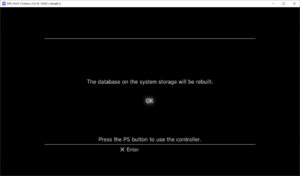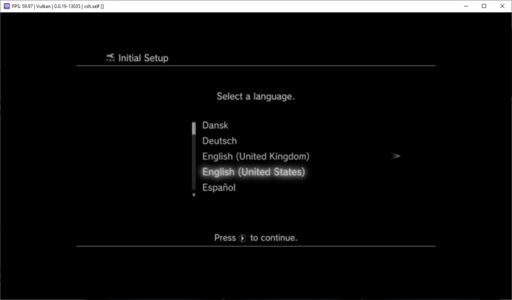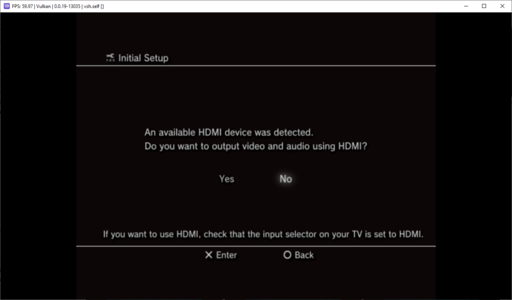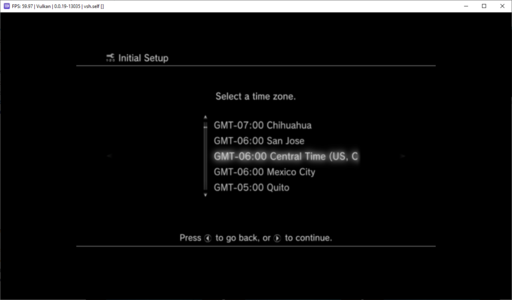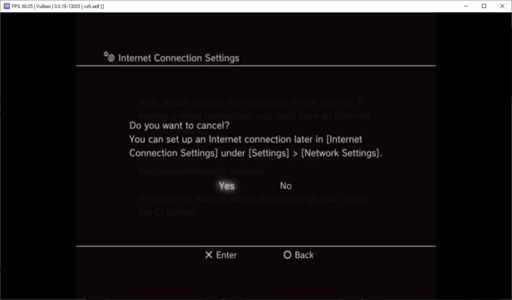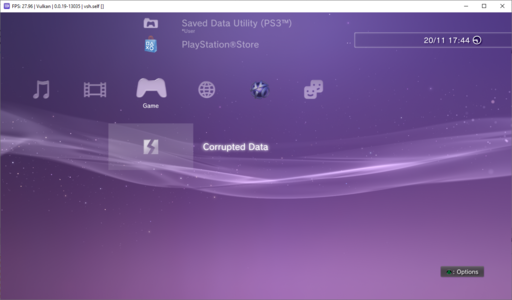No edit summary |
m (Fixed grammar and spelling) |
||
| (2 intermediate revisions by one other user not shown) | |||
| Line 100: | Line 100: | ||
==Adding Trophy and Home Menu sounds== | ==Adding Trophy and Home Menu sounds== | ||
RPCS3 allows users to add PS3 or their own custom sounds. Here how you can | RPCS3 allows users to add PS3 or their own custom sounds. Here is how you can do it: | ||
#Extract sounds from <code>dev_flash\vsh\resource\system_plugin.rco</code> using [https://github.com/kakaroto/RCOMage RCOMage] (Skip this step if you have your own sounds). | #Extract the sounds from <code>dev_flash\vsh\resource\system_plugin.rco</code> using [https://github.com/kakaroto/RCOMage RCOMage] (Skip this step if you have your own sounds). | ||
#Place | #Place the extracted files (or your own ones) to <code>RPCS3\sounds</code> on Windows or <code>~/.config/rpcs3/sounds/</code> on Linux. | ||
Now you can enjoy Trophy notification and Home Menu sounds! | Now you can enjoy Trophy notification and Home Menu sounds! | ||
''<u>Note</u>: Remember that files need to be named the '''same way''' as on PS3 and in '''WAV''' format. More info can be found [https://www.psdevwiki.com/ps3/RCOXML_ofw_sounds here]'' | |||
Latest revision as of 10:56, 11 June 2023
This is a page meant to address common questions and issues faced by users.
Running VSH/XMB in RPCS3
Since July 2021, it has been possible to run VSH/XMB on the official master builds of the emulator, bearing in mind some quirks and limitations. The initial set-up is as follows:
Configuration
Make the following modifications to the Global configuration.
Options that deviate from RPCS3's default settings and provide the best experience with this title are listed below.
CPU configuration
| Setting | Option | Notes |
|---|---|---|
| PPU decoder | Interpreter (static) | Can be used for a smoother experience during initial setup. |
GPU configuration
| Setting | Option | Notes |
|---|---|---|
| Default resolution | 1920x1080 | Can be used if you prefer a Full HD presentation. |
Debug configuration
This tab is hidden by default. For instructions on how to enable the Debug tab in the settings window, click here.
| Setting | Option | Notes |
|---|---|---|
| Force CPU blit emulation | On | Fixes broken audio. Requires Write Color Buffers to fix the missing background wave effect. |
Initial Setup
The initial setup consists of two phases. The first phase is as follows:
- Select
File > Boot VSH/XMBto get started. VSH will have to rebuild its XRegistry database. You may notice that the image output is low resolution, and has a 4:3 aspect ratio. This is completely normal and the expected behavior. - Afterwards, you will be greeted by the intro logo.
- You'll be presented with the language selection menu. Select your desired language and Press X.
- Next, you will be met with a message, saying that an HDMI display was detected. Choose Yes.
- Following this, you'll be asked to select your timezone and the current time. You can just spam X to get through these, especially the current time selection part (it will autofill if you hit X a couple of times).
- Once done, Press Right. If you've done everything correctly (the summary page looks correct), Press X to finish the setup.
- Before letting you into the main menu, VSH will ask you if you want to set up a network connection. It is recommended that you do not.
- Confirm the new user profile creation and... Welcome to the PS3!
- This concludes the initial setup of the VSH / XMB.
To correctly turn off VSH:
- Navigate to
Users > Turn Off Systemoption. VSH will throw a database corruption prompt on the next boot if you do not shut it down this way. - After selecting the option, the screen will turn black. You can then proceed to manually exit VSH at this point.
Notes:
- It is recommended to boot VSH up back again after this, to ensure everything worked correctly, and to collect some extra PPU module cache. To build all PPU caches click File -> All Titles -> Create PPU Cache. This can help VSH run smoother.
- Make sure to revert the
PPU Decoderoption to Recompiler (LLVM) after you're done, in case you've set it to Interpreter (fast) for the duration of the setup process.
Limitations
At its current stage, VSH has several quirks and limitations:
- There's no multi-process support yet, meaning you can not use XMB as a frontend to boot into games or other applications.
- Due to encryption several instances of Corrupted Data show erroneously in place of Game Data.
- Restarting and shutting down doesn't work automatically yet, hence why you have to do it manually as explained above, or delete the rpcs3/dev_hdd0/tmp/turnoff file between boots.
Troubleshooting
In case you somehow manage to brick it, you can try removing the dev_flash2 and dev_flash3 folders from the RPCS3 directory. This will put you back at square one. You will need to do the initial setup again.
Enabling Debug tab
To enable RPCS3's debug tab in the settings window,
- Navigate to:
RPCS3\GuiConfigson Windows~/.config/rpcs3/GuiConfigson Linux~/Library/Application Support/rpcs3/GuiConfigson MacOS
- Open CurrentSettings.ini with a text editor
- Change
showDebugTab=falsetoshowDebugTab=true
Modifying settings through config.yml
In most cases, users should use the Settings tab available in the GUI to modify configurations present in RPCS3. However, the GUI interface does not expose all settings available. This is done to prevent users from accidentally modifying sensitive settings. In the event users need to modify one of these settings, the following guide will demonstrate how:
- First, a custom configurations for the particular game must be created. This is done to ensure that changes made only affect one game and not every game present in the emulator:
- Launch RPCS3.
- Right-click on the game and press Create Custom Configuration.
- When the Settings Menu opens, hit Save and close the emulator.
- This will create a custom configuration for this game.
- The next step is navigate to the location where the custom (per-game) configuration is saved:
- Right click on the game in the gamelist and click on Open custom config folder or
Navigate toRPCS3\config\custom_configs\on Windows or~/.config/rpcs3/custom_configs/on Linux. - Locate the file
config_GAMEID.ymlwhereGAMEIDis the Title ID of your particular game. - Open the file using any text editor.
- Scroll through the list of settings available to find the one you wish to modify. Don't forget to hit save after you've changed the necessary option.
- Right click on the game in the gamelist and click on Open custom config folder or
List of CLI commands
If you want to use RPCS3 through CLI, you can type --help to view the full list of commands available.
Vulkan renderer unable to be selected
In some cases, the Vulkan renderer does not appear as an option. There are some solutions to try to resolve this:
- Confirm that your GPU does support Vulkan, as it will not appear if the GPU does not support it.
- AMD GPUs older than the HD 7000 series (Southern Islands/GCN 1st gen) do not support Vulkan.
- NVIDIA GPUs older than the Geforce 600 (Kepler) series also do not support Vulkan.
- Update your GPU's drivers. If your specific setup contains an NVIDIA GPU and an AMD GPU (such as a laptop with dedicated graphics) then make sure to update the drivers for both GPUs and keep them updated.
- Download the vkDiag tool written by 13xforever and run it on your PC. If it asks you to remove broken entries or disable incompatible Vulkan layers (or both in some cases), tell it to do so.
- If the above does not resolve the issue, then it may be required to use the Display Driver Uninstaller tool to completely remove your GPU's drivers from your PC to do a clean reinstall of them. If you choose to do this option, please download the latest version of your GPU's drivers in a .exe format (such as with GeForce Experience or the AMD Radeon Software), disconnect from the internet and boot into Safe Mode when running the DDU tool and reinstalling GPU drivers. Once the drivers have been reinstalled, you can reboot back into regular Windows and reconnect to the internet.
Adding Trophy and Home Menu sounds
RPCS3 allows users to add PS3 or their own custom sounds. Here is how you can do it:
- Extract the sounds from
dev_flash\vsh\resource\system_plugin.rcousing RCOMage (Skip this step if you have your own sounds). - Place the extracted files (or your own ones) to
RPCS3\soundson Windows or~/.config/rpcs3/sounds/on Linux.
Now you can enjoy Trophy notification and Home Menu sounds!
Note: Remember that files need to be named the same way as on PS3 and in WAV format. More info can be found here
